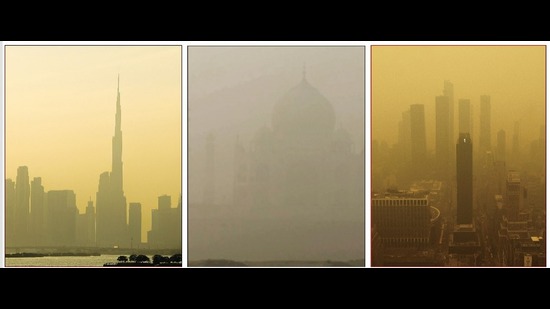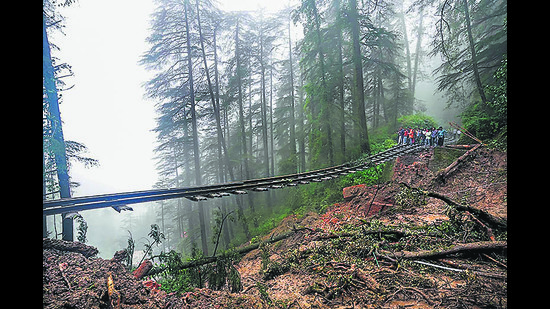After a year of fumes, fire, flood, will hope bloom in 2024?: Trade-Offs by Mridula Ramesh
We can be guided, this year, by a simple truth: Change is wrought most profoundly by how we act. What we choose to do; buy (and not buy); and what we vote on.
2023 began with a town sinking. Joshimath, a pilgrimage stop nestled deep in the Himalayas, at an altitude of over 6,000 ft, saw its houses and roads develop cracks as parts of it sank. There were several explanations for this. Some pointed to the town coming up on landslide debris. Others blamed its location, next to a geological fault line. Still others said the rocks beneath the town allowed rain and snow melt to seep in, creating hollows that destabilised it.

Then there were the dams. A large hydroelectric project lies close to Joshimath. In 2009, a tunnel-boring machine employed in this project punctured an underground aquifer, releasing enough water to fill 5,000 large aircraft. As the water escaped, some posited, the land over it collapsed, almost like a slowly deflating balloon. Others blamed the blasting and deforestation undertaken to build roads and houses. When intense rain then fell on the bald and unstable slopes, it dragged the land downward. Joshimath’s fate was sealed.
It’s a story with two lessons. The first is that our path of development needs to be revisited. The second lesson emerged later: the real problem is that our attention span is tiny.
No worries, the planet replied, “I’ll send more reminders.” As the year progressed, halfway around the world, a great change was underway. For three years, the planet had enjoyed a relative breather from scorching temperatures, thanks to a back-to-back La Nina climate pattern. That was ending. Over the next few months, an El Nino climate pattern developed, warming the world and changing global rainfall patterns.
In India, the El Nino made the monsoon more temperamental. Early signs were visible in late-April, far from the headlines, where the summer crop of tomatoes was struggling to cope in climate that was too hot and dry. By mid-May, heatwaves wracked cities and farms.
Since 1971, most of the heat trapped within the planetary system — about 90% — has been held by the oceans. Such heating makes ice sheets melt, and seas rise and become more acidic. Hotter seas birth more powerful cyclones. Indeed, the World Meteorological Organization categorised Cyclone Mocha, which displaced 1.7 million people in mid-May, one of the most intense cyclones ever observed in the Bay of Bengal.

On the other side of the planet, Canada was burning. And how it burnt. More than 18.5 million hectares of forest ablaze, with the smoke plumes spreading out across hundreds of kilometres. In early June, New York overtook New Delhi to become the world’s most polluted city, as the smoke turned its skies an apocalyptic orange.
Firefighters from around the world converged in Canada to battle the flames, a heart-warming sign that we are all in it together. But through the year, East Africa battled intense floods, in relative obscurity and somewhat alone. Which raised the question: Are we really?
Closer to home, the monsoon arrived a week later than usual. Then, Biparjoy (meaning Disaster in Bangla) flooded parts of Gujarat. July brought more floods, in Punjab, Rajasthan, Uttarakhand, Himachal Pradesh and Delhi. The Yamuna rose and displaced more families. The Red Fort was inundated. Himachal Pradesh was deluged; several districts set all-time records for intense rainfall. Homes, lives and crops were carried away in a muddy avalanche.
Some of Joshimath’s lessons were relevant.
***
July has always seen tomato prices spike, because that’s when India must depend on smaller harvests from its cooler regions. Last year, Karnataka’s crop was hit by a vicious pest attack (thanks to heat and unusual rains) and Himachal’s crop was partly washed away. So, prices rose and rose. There was bawling and theft, as people hijacked trucks of tomatoes.
As August rolled around, floods hit Himachal Pradesh and Uttarakhand again. “Lest you forget,” said the planet. News of farmer suicides began trickling in from Marathwada to Punjab. By October, a glacier lake burst open and flooded Sikkim and the fires began to burn again, as farmers cleared the stubble to plant their winter crop, turning Delhi noxious.
Every year, it’s a predictable circus. All is quiet. Then by October, the chatter begins. By early November, the drama peaks, then ebbs away. The wealthy hide in shuttered rooms with air purifiers, while poorer lungs are left with little to protect them.
Why would any politician risk valuable political capital by taking tough action when we are far more interested in actor Matthew Perry and gangster Atiq Ahmed? Incentives matter. Our tiny attention span does not help.
As November progressed, Chennai turned fearful eyes towards the swollen skies. On Saturday, December 3, people were asked to stock up and hunker down. By Monday, the neighbourhoods of Pallikaranai, Velachery and Madipakkam had flooded. After all, they had been lakes and marshlands, designed to capture runoff from intense rain.
Weather models had suggested that the rain would be at its most intense for a couple of hours on Monday afternoon. But the low-pressure system caused by Cyclone Michuang stayed put for a few hours longer than predicted, and opened the skies over Chennai. Areas that typically don’t flood, flooded. Almost no one was spared. But the wealthy were rescued. The middle-class had food. But in several neighbourhoods, people went without clean water, food or working toilets for days. The so-chipper-you-want-to-punch-someone-in-the-nose hashtag of #ChennaiHelps did not trend this time. Predictably, when calamity becomes an annual affair, the milk of human kindness can run dry. A couple of weeks later, the south of Tamil Nadu was deluged, with several parts getting more than their annual rainfall in a day. This is the new climate we must prepare for.
Meanwhile, far away in the desert city of Dubai, thousands congregated for the annual United Nations Conference of the Parties (COP). The irony, as others have noted, was that this COP — the planet’s attempt to stave off climate disaster — was hosted by a country that lives and breathes oil. The jaded press celebrated the creation of a loss-and-damages fund – money from developed countries to pay poorer nations for climate damage and losses. Less spoken-about was the fact that the amount paid into the fund was not much more than what Tamil Nadu had asked for, to counter the damage inflicted by one flood, in one city.
Yet, on the sidelines of the official negotiations, there was palpable energy — deals were made, projects funded, partnerships forged, ideas discussed — suggesting that real, scalable action could come to pass.
That brings me to hope. In 2023, India landed on the moon. Solar and electric vehicles entered the mass-market phase, unthinkable just a few years ago. That’s the beauty of enterprise. It can move fast, but needs policy to set the guardrails. Climatech is now the “It Girl” of start-up investing. Last year I saw over a thousand people converge at a climatetech conference in Chennai. If we can overcome greenwashing and craft policy to build resilience, that hope might even translate into meaningful action. If.
It is possible. One story made me very happy. Two years ago, I wrote of how a good mahua liquor could help save forests, our frontline climate warriors. Mahua flowers are collected by tribal women in a way that risks both their lives and the health of the forest with little reward. So much mahua rots, and tribal families make very little money. But Mond, a branded mahua liquor, produced to exacting standards by tribal women being paid steady wages, is flying off the shelves. Tasting such a liquor on a recent trip to Madhya Pradesh was sweet in more ways than one.
There is also good policy emerging to protect lakes, including the launch of first-ever water body census of India.
Will hope blossom further in 2024? That depends. Will our political leaders believe that setting climate-resilient policy will win them votes in a vital year? Maybe. Maybe not.
After all, we forgot Joshimath. And Himachal Pradesh, Sikkim, the smoke and Chennai. This reality blunts hope. And yet, climate models suggest that the El Nino pattern could persist until early summer, making for a hot and dry pre-monsoon season and chances of more reminders of our climate negligence. Maybe that will keep up the pressure for good policy.
Let me end with a personal story. Our factory was deluged in the south Tamil Nadu rains. But we had desilted and cleaned the water channels along most of the campus earlier that year. This meant a quick mucking out of one channel outside our factory made the water drain quickly away.
Which shows that, amid the gloom, lies a simple truth: True change is wrought most profoundly by how we act. By what we choose to do; buy (and not buy); and what we vote on.
This is sobering but empowering. And that’s the trade-off we must navigate in 2024.
(Mridula Ramesh is a climate-tech investor and author of The Climate Solution and Watershed)








